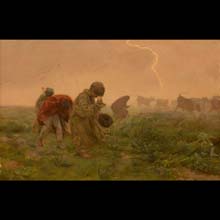
material: oil on canvas
dimensions: 107 × 163 cm
description: Towards the end of the 19th century, Józef Chełmoński’s painting was appreciated not only by art critics but also by the public, aspiring to the status of the model of Polish landscape painting. His works were compared to the oeuvre of Jan Matejko. Thunderstorm, exhibited in Krakow in 1896, earned him the Probus Barczewski award of the Polish Academy of Arts and Sciences. The work depicts uncontrollable elements of nature and people’s reaction to them. In the centre of this dynamic composition, one can see rural children herding cattle. Surprised by the storm, lashed by rain and wind, they are cowering, scared by the violence of nature. The horror of people and animals corresponds to the vast, gloomy landscape. The artist has rendered the biological determinism of human behaviours in an evocative, narrative style. The use of religious symbolism – the sign of the cross made by the shepherd boy – alludes to the strong and genuine but at the same time blind faith of the common people, while dark, earth tones of the children’s clothes highlight their poverty and low social status. The motif of shepherds, popular in European painting, has acquired a poetic quality in this work, reflecting the artist’s deeply emotional attitude to the countryside. Aleksandra Krypczyk
exposition: The Gallery of 19th Century Polish Art in Sukiennice,
The Cloth Hall, 1, Main Market Square
key: Realism, polish impressionism, beginnings of symbolism >>>
dimensions: 107 × 163 cm
description: Towards the end of the 19th century, Józef Chełmoński’s painting was appreciated not only by art critics but also by the public, aspiring to the status of the model of Polish landscape painting. His works were compared to the oeuvre of Jan Matejko. Thunderstorm, exhibited in Krakow in 1896, earned him the Probus Barczewski award of the Polish Academy of Arts and Sciences. The work depicts uncontrollable elements of nature and people’s reaction to them. In the centre of this dynamic composition, one can see rural children herding cattle. Surprised by the storm, lashed by rain and wind, they are cowering, scared by the violence of nature. The horror of people and animals corresponds to the vast, gloomy landscape. The artist has rendered the biological determinism of human behaviours in an evocative, narrative style. The use of religious symbolism – the sign of the cross made by the shepherd boy – alludes to the strong and genuine but at the same time blind faith of the common people, while dark, earth tones of the children’s clothes highlight their poverty and low social status. The motif of shepherds, popular in European painting, has acquired a poetic quality in this work, reflecting the artist’s deeply emotional attitude to the countryside. Aleksandra Krypczyk
exposition: The Gallery of 19th Century Polish Art in Sukiennice,
The Cloth Hall, 1, Main Market Square
key: Realism, polish impressionism, beginnings of symbolism >>>












